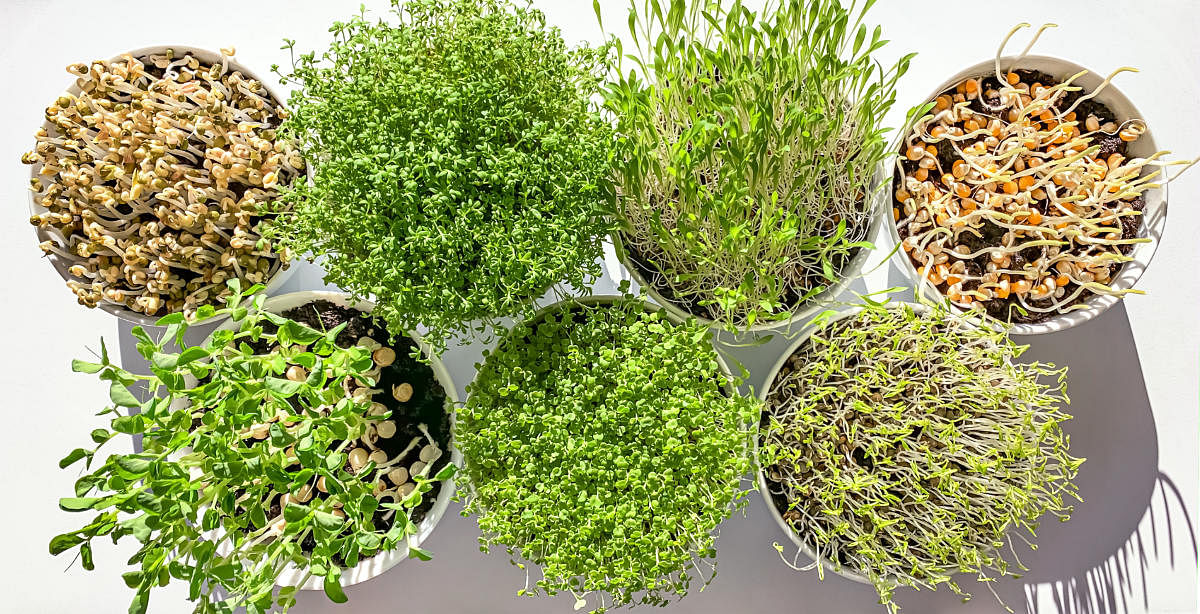
The pandemic has triggered new passions in many, considering much of last year was spent homebound. And gardening seems to be topping the list of most favourite hobbies. While some are opting for aesthetic gardening and going for ornamental plants, many have spent the year sprucing up their kitchen gardens. Little wonder than that microgreens have emerged as the new flavour of the season.
For the uninitiated, microgreens are baby plants at a stage when the first true leaves appear. With the harvesting time not cast in stone, one can pluck and consume the microgreens anytime between 7–21 days after germination.
Nutritionists swear by microgreens as concentrated sources of minerals, vitamins and antioxidants. Chefs at fancy hotels prize them for their aromatic flavours, colour and texture; urbanites see in them homegrown food; and those hungry for residue-free leafy vegetables find them to be a great alternative to store-bought greens. And, with such an obvious rise in demand, can entrepreneurs be left behind? Many enterprising homemakers have, in fact, started small microgreens’ businesses, making use of their green thumb, as it were. There’s nothing not to love about microgreens — easy to grow, great as a hobby, adds greenery to your home and are super healthy to boot. Before you lose that enthusiasm, here are some important dos and don’ts.
Which seeds to use?
The traditional Indian masala box comprising fenugreek, mustard, fennel seeds, etc., offer a good range of options for the beginner. A safe bet is to select the vegetables you would probably buy at a store — amaranthus, spinach, dill, radish, lettuce, onion and garlic — are all great choices.
The more unusual ones like flax seeds and chia, or even green gram and groundnut can be grown, but with some caution. Often, people get surprised by how different the same vegetables taste when bought at a store and when grown at home. The taste of microgreens, being a concentrated source of nutrition, varies depending on the kind of seed chosen. The range is diverse; some could be spicy, others sour or even bitter. For instance, mustard or radish usually end up being pungent, while spinach and amaranthus show up as neutral.
Soil and containers
The ideal potting mix is equal parts of compost, sand and coco peat. Alternatively, only coco peat, or compost and coco peat in equal quantities could also be used. The microgreens are well held by shallow plastic containers with a depth of two-three inches and proper drainage holes.
Method of growing
Fill tray with seed, sowing the mix up to a depth of one-two inches. Dampen it by spraying a little water.
Gently sprinkle the seeds on top.
Cover the seeds with the potting mix to about half an inch on top and gently press it down.
Spray water on the soil and cover the surface with a wet towel or a newspaper.
Place the tray in a well-ventilated place away from direct sunlight.
Check surface level moisture from time to time and ensure minimal moisture without making it soggy.
Seeds begin to sprout in two-three days. Remove paper/towel and continue spraying water.
Harvest anytime between 7-21 days, depending on the crop chosen and the required stage of consumption.
Either cut (with a scissor) only the shoots, or harvest the whole plant at one go.
Harvest only when needed.
Microgreens are traditionally used in raw form to garnish pizzas, omelettes, pasta, burgers, sandwiches and salads. In Indian cuisine, they can be sprinkled on chhole, pav bhaji, dhokla, chats, etc. They can be juiced up for a healthy drink with ginger or mint, or added to smoothies or even panipuri pani. Microgreens can also be cooked as stir fries or added to dals, curries, chutneys and dips in right quantities.
A word of caution though. Never overdo anything. The research findings vis-à-vis consumption of vegetables have been extrapolated to microgreens; however, nothing definite is known specifically about them, except for their nutritional potential.
The type of greens, the frequency and quantity of consumption are yet to be standardised. As suggested by some nutritionists, consuming one fourth the quantity of normal greens should be the thumb rule. Another advice is to rotate the cultivation and consumption
of microgreens along with other vegetables.